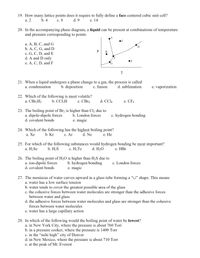
Chemistry
10th Edition
ISBN: 9781305957404
Author: Steven S. Zumdahl, Susan A. Zumdahl, Donald J. DeCoste
Publisher: Cengage Learning
expand_more
expand_more
format_list_bulleted
Question
Please help me with questions 21 & 22. Thank you in advance.

Transcribed Image Text:### Phase Diagram and Chemistry Quiz
#### Questions:
**19. How many lattice points does it require to fully define a face-centered cubic unit cell?**
- a. 2
- b. 4
- c. 8
- d. 9
- e. 14
**20. In the accompanying phase diagram, a liquid can be present at combinations of temperature and pressure corresponding to points:**
- a. A, B, C, and G
- b. A, C, G, and D
- c. G, C, D, and E
- d. A and D only
- e. A, C, D, and F
*Explanation of the Phase Diagram:*
The diagram is a typical phase diagram with Pressure (P) on the vertical axis and Temperature (T) on the horizontal axis. It shows several marked points (A, B, C, D, E, F, G) illustrating different phases. Phase boundaries are indicated showing conditions under which different phases (e.g., solid, liquid, gas) exist.
**21. When a liquid undergoes a phase change to a gas, the process is called:**
- a. condensation
- b. deposition
- c. fusion
- d. sublimation
- e. vaporization
**22. Which of the following is most volatile?**
- a. CBr₂H₂
- b. CCl₃H
- c. CBr₄
- d. CCl₄
- e. CF₄
**23. The boiling point of Br₂ is higher than Cl₂ due to:**
- a. dipole-dipole forces
- b. London forces
- c. hydrogen bonding
- d. covalent bonds
- e. magic
**24. Which of the following has the highest boiling point?**
- a. Xe
- b. Kr
- c. Ar
- d. Ne
- e. He
**25. For which of the following substances would hydrogen bonding be most important?**
- a. H₂Se
- b. H₂S
- c. H₂Te
- d. H₂O
- e. HBr
**26. The boiling point of H₂O is higher than H₂S due to:**
- a. ion-dipole forces
- b. hydrogen bonding
Expert Solution
This question has been solved!
Explore an expertly crafted, step-by-step solution for a thorough understanding of key concepts.
Step by stepSolved in 2 steps

Knowledge Booster
Learn more about
Need a deep-dive on the concept behind this application? Look no further. Learn more about this topic, chemistry and related others by exploring similar questions and additional content below.Similar questions
- help please answer in text form with proper workings and explanation for each and every part and steps with concept and introduction no AI no copy paste remember answer must be in proper format with all workingarrow_forward1. LIAIH4 2. H20 of 1. (CH3CH2)2CuLi 2. H20, H* 1. CO2 2. НаО, Н* `MgBrarrow_forwardIn the space provided below draw a micelle (hydrophilic micelle) and an inverted micelle (a lipophilic micelle). Label the drawings and also label the components clearly. Explain how the two micelles are different from each other. micelle (hydrophilic micelle) inverted micelle (a lipophilic micelle) Explain how the two micelles are similar to each other. Explain how the two micelles are different from each other. In your own words explain how soap removes grease from your hands.arrow_forward
- (Thanks for the help if you can break down the steps and provide drawings(needed) during the answer since i am trying to see if i have solved this in the right way not copy :)) Draw the heme environment in oxymyoglobin and explain how the geometric data for the attached oxygen molecule may be understood. Fe O (bond length) = 1.809 Å; O-O (bond length ) = 1.246 Å; Fe - O - O (bond angle) = 123 \degarrow_forwardAmmonia must be eliminated from wastewater before it can be reused, recycled, or discharged. Describe the three major steps that are used to convert harmful ammonia into a harmless derivative. Your answer must be specific and include any appropriate chemical formulas or names of chemical or biological reagents. Mention, when appropriate, the toxicity of any of the components or how their production can get in the way of efficiently eliminating ammonia from wastewater.arrow_forwardThe following Statin is called Pravastatin. It is used to help lower high levels of LDL-C in patients with Familial Hypercholesterolemia (FH). USE DIFFERENT COLORS FOR FOLLOWING QUESTIONS! Circle the Pharmacophore. Box the Functional groups.arrow_forward
arrow_back_ios
arrow_forward_ios
Recommended textbooks for you
 ChemistryChemistryISBN:9781305957404Author:Steven S. Zumdahl, Susan A. Zumdahl, Donald J. DeCostePublisher:Cengage Learning
ChemistryChemistryISBN:9781305957404Author:Steven S. Zumdahl, Susan A. Zumdahl, Donald J. DeCostePublisher:Cengage Learning ChemistryChemistryISBN:9781259911156Author:Raymond Chang Dr., Jason Overby ProfessorPublisher:McGraw-Hill Education
ChemistryChemistryISBN:9781259911156Author:Raymond Chang Dr., Jason Overby ProfessorPublisher:McGraw-Hill Education Principles of Instrumental AnalysisChemistryISBN:9781305577213Author:Douglas A. Skoog, F. James Holler, Stanley R. CrouchPublisher:Cengage Learning
Principles of Instrumental AnalysisChemistryISBN:9781305577213Author:Douglas A. Skoog, F. James Holler, Stanley R. CrouchPublisher:Cengage Learning Organic ChemistryChemistryISBN:9780078021558Author:Janice Gorzynski Smith Dr.Publisher:McGraw-Hill Education
Organic ChemistryChemistryISBN:9780078021558Author:Janice Gorzynski Smith Dr.Publisher:McGraw-Hill Education Chemistry: Principles and ReactionsChemistryISBN:9781305079373Author:William L. Masterton, Cecile N. HurleyPublisher:Cengage Learning
Chemistry: Principles and ReactionsChemistryISBN:9781305079373Author:William L. Masterton, Cecile N. HurleyPublisher:Cengage Learning Elementary Principles of Chemical Processes, Bind...ChemistryISBN:9781118431221Author:Richard M. Felder, Ronald W. Rousseau, Lisa G. BullardPublisher:WILEY
Elementary Principles of Chemical Processes, Bind...ChemistryISBN:9781118431221Author:Richard M. Felder, Ronald W. Rousseau, Lisa G. BullardPublisher:WILEY

Chemistry
Chemistry
ISBN:9781305957404
Author:Steven S. Zumdahl, Susan A. Zumdahl, Donald J. DeCoste
Publisher:Cengage Learning

Chemistry
Chemistry
ISBN:9781259911156
Author:Raymond Chang Dr., Jason Overby Professor
Publisher:McGraw-Hill Education

Principles of Instrumental Analysis
Chemistry
ISBN:9781305577213
Author:Douglas A. Skoog, F. James Holler, Stanley R. Crouch
Publisher:Cengage Learning

Organic Chemistry
Chemistry
ISBN:9780078021558
Author:Janice Gorzynski Smith Dr.
Publisher:McGraw-Hill Education

Chemistry: Principles and Reactions
Chemistry
ISBN:9781305079373
Author:William L. Masterton, Cecile N. Hurley
Publisher:Cengage Learning

Elementary Principles of Chemical Processes, Bind...
Chemistry
ISBN:9781118431221
Author:Richard M. Felder, Ronald W. Rousseau, Lisa G. Bullard
Publisher:WILEY